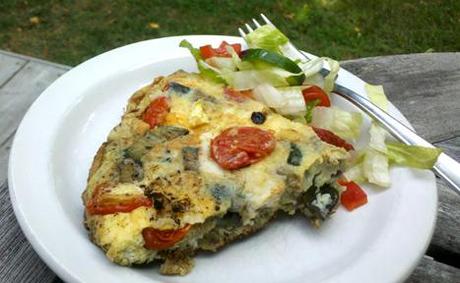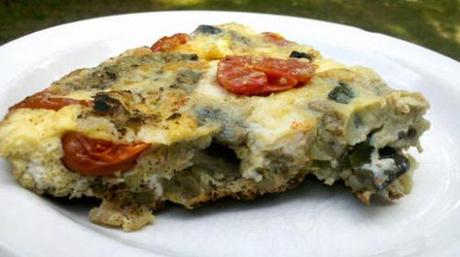
Roasted tomato, zucchini, eggplant, and Brie fritatta. Recipe at end of post.
Awhile ago I was contacted by a complementary medicine advocate, Jillian McKee, of the Mesothelioma Cancer Alliance about sharing an article she had written about the importance of healthy nutrition while undergoing cancer treatments.
Though I haven’t had cancer myself, my life has been touched by it. I’m sure most of you also know someone who has battled cancer, whether it is a loved one, relative, friend, or a friend of a friend or relative of a friend…. It’s such a prevalent disease.
Treating cancer and living with the disease on a day to day basis is such a physically and emotionally draining experience. It’s important to fuel your body properly to keep up your strength. Jillian outlines the best way to do this.
This information might already be familiar to some people. For others it might be new and helpful. I think it is important to spread the word.
*****************************************************************************
Good Nutrition Can Boost Your Chances of Surviving Cancer
By Jillian McKee
If you’ve recently been diagnosed with cancer or are going through treatments, you may be wondering what you can do to improve your odds for survival. Although surgery, chemotherapy, radiation and other treatment methods are important to the recovery process, tailoring good nutritional principles to fit your current condition can help you tolerate the side effects better and give you the mental strength you need to get through this.
Cancer can negatively affect your appetite and sometimes change the way your body handles particular foods such as dairy products; hunger is no longer a good indicator that you’re getting the nutrition you need. For that reason, educating yourself about good nutrition can be as essential to your survival as your individual treatment plan is. Whether you have a lung tumor, a growth on your prostate, or some other type of malignancy, good nutrition can make a difference in the outcome.
When fighting cancer, nutritional guidelines are slightly different from standard recommendations. Many cancer patients struggle to implement these guidelines, especially if they didn’t think about nutrition before their diagnosis. For those who are new to nutrition, here’s a little help.
Protein
Cancer patients need additional protein for healing. When you don’t get enough, the body cannot guard itself against infection because it can’t make white blood cells for the immune system. It also can’t repair damaged tissue that treatment might have caused. Protein comes in complete and non-complete forms depending upon the amount of amino acids the food contains.
Proteins such as eggs, yogurt, milk, cheese, soybeans and quinoa contain all eight essential amino acids that the body needs, so they are called complete proteins. Rice, nuts, beans, tortillas, pasta, bread and cereals contain lesser amounts, so they are called incomplete proteins. The body takes the amino acids from one food and mixes them together with the amino acids found in other food; so most protein sources are good for cancer patients.
Carbohydrate
Carbohydrates are starches and sugars that provide the body with glucose and the calories you need for energy. Fruits, vegetables, and grains also supply vitamins and minerals. It does that with the help of the hormone insulin. When insulin levels rise, it helps the glucose enter your body’s cells for immediate energy. What the body cannot use is stored as glycogen in the liver. If glycogen stores are full, the body will store the glucose as body fat.
Healthy Fats
Many cancer patients have trouble eating enough calories. Healthy fats such as olive oil, peanut oil, nuts, sunflower seeds and avocados supply essential fatty acids the body needs, but they can also be used for energy or calories to help you maintain weight. If you’re having trouble eating enough, healthy, unsaturated fats are a good way to get in additional calories.
*****************************************************************************
Thanks so much, Jillian, for allowing me to share this vital information with my readers!
I made this vegetable frittata last night from local produce grown in Long Island. Served with a healthy grain, it covers all the nutritional basis in the article.

Roasted Tomato, Zucchini, Eggplant, and Brie Frittata
1 cup grape tomatoes
5 teaspoons olive oil, divided
kosher salt
1 small globe eggplant
1 medium zucchini
pepper
1/2 teaspoon dried thyme
8 eggs
1/4 cup grated parmesan
about 1-2 oz. Brie or other soft cheese, cut into small pieces
1. Preheat oven to 275 degrees F.
2. Halve grape tomatoes, toss in about 1 teaspoon olive oil, sprinkle with a pinch of salt, and arrange in a single layer on a foil lined baking sheet, cut sides up. Roast in oven for about 40-45 minutes until soft. Set aside.
3. Slice ends off eggplant. Cut eggplant into 1/2-inch slabs vertically. Salt each side with kosher salt and place in colander. Let sit about 20 minutes.
4. Meanwhile, cut off ends of zucchini, slice into 1/2-inch slabs vertically. Then cut into 1/2-inch strips, then cubes. Place in a large bowl.
5. Rinse salted eggplant and pat dry. Cut into 1/2-inch strips, then cubes. Add to bowl of cubed zucchini and toss mixture with 3 teaspoons olive oil, pinch of salt, pepper, and dried thyme.
6. Beat eggs in a separate bowl. Add parmesan and mix to incorporate. Set aside.
7. Heat 1/2 teaspoon oil in a large skillet. Add cubed zucchini and eggplant to skillet. Saute until slightly browned on sides. Add 1/4 cup water, cover skillet, cook on low for about 5 more minutes until vegetables are soft. Uncover and cook until all the liquid has evaporated (if it hasn’t already). Add roasted tomatoes. Stir to combine.
8. Pour egg mixture over vegetables and stir gently to let egg reach the bottom. Dot top with pieces of Brie. Cover pan and cook on low for about 8 minutes.
9. Loosen sides and bottom of frittata with spatula. Then cover pan with a large plate (larger in diameter than the skillet). Turn plate covered skillet over so frittata plops onto plate.
10. Coat skillet with remaining 1/2 teaspoon oil. Slide frittata back in pan. Cover and cook for another two minutes. Flip frittata again in same manner onto plate. Cut into wedges and serve.

